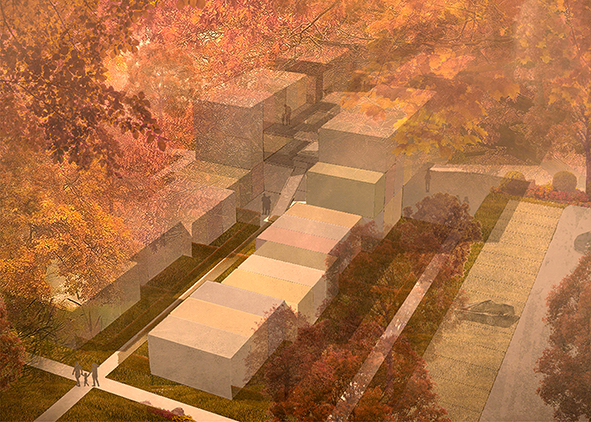The impermanence as resource for building redevelopment
DOI:
https://doi.org/10.19229/2464-9309/4142018Keywords:
temporary architecture, flexibility, building renewal, energy upgrading, urban qualityAbstract
The current economic situation produced disruptive consequences on population ways of living. To this, it has to be added the crisis of the duration, linked to the technological progress’ evolution, which led to a sudden regression of the existing building stock making necessary to act on it to reach for its adaption to standards, not only in regulatory terms. Therefore, the present contribution aims at define, through the development of a proposal for the Pilastro district in Bologna, a strategy to ease the interventions on such assets by means of the adoption of a temporary architecture, prototype of a new concept of urbanity, effective even for other purposes complementary to the redevelopment of existing buildings and suitable for different application contexts.
Downloads
Article Metrics Graph
References
Angelucci, F., Di Sivo, M. and Ladiana, D. (2013), “Reattività, adattabilità, trasformabilità: i nuovi requisiti di qualità dell’ambiente costruito”, in Techne | Journal of Technology for Architecture and Environment, vol. 5, pp. 53-59.
Bellicini, L. and Ingersoll, R. (2001), Periferia italiana, Meltemi Editore, Roma.
Boeri, A., Antonini, E. and Longo, D. (2013), Edilizia sociale ad alta densità – Strumenti di analisi e strategie di rigenerazione – Il quartiere Pilastro a Bologna, Mondadori Bruno Editore, Milano.
Bologna, R. (2002), La reversibilità del costruire, Maggioli Editore, Rimini.
Bologna, R. and Terpolilli, C. (2005), Emergenza del progetto/progetto dell’emergenza – Architetture con-temporaneità, Edizioni F. Motta, Milano.
Brownlee, T. D., Cesario, E., Ottone, F. and Pirro, S. (2016), “Can temporary architecture improve outdoor conditions in residential districts?”, in Proceedings of the 41st IAHS World Congress – Sustainability and Innovation for the future, Albufeira, Algarve, Portugal, September 13-16, 2016, International Association for Housing Science, Algarve.
Clemente, M. (2005), Estetica delle periferie urbane – Analisi semantica dei linguaggi dell’architettura spontanea, Officina Edizioni, Roma.
Conato, F. and Frighi, V. (2016), “Moderno ed efficienza energetica: riqualificare, ricostruire o sostituire?”, in L’UFFICIO TECNICO, vol. 9, pp. 8-13.
Coppola, A. (2016), Apocalypse Town, Editori Laterza, Roma-Bari.
Di Giulio, R., Boeri, A., Forlani, M. C., Gaiani, A., Manfron, V. and Pagani, R. (2013), Paesaggi periferici, Quodlibet, Macerata.
Falasca, C. (2000), Architetture ad assetto variabile, Alinea Editrice, Firenze.
Fassi, D. (2012), Temporary Urban Solutions – Soluzioni temporanee per la città, Maggioli Editore, Rimini.
Firrone, T. (2009), Innovative Technologies for Temporary Architecture. [Online] Available at: iris.unipa.it [Accessed 26 September 2018].
Firrone, T. (2007), Sistemi abitativi di permanenza temporanea, Aracne Editrice, Roma.
Giachetta, A. (2004), Architettura e tempo – La variabile della durata nel progetto di architettura, Libreria CLUP, Milano.
Grecchi, M. (2008), Il recupero delle periferie urbane, Maggioli Editore, Rimini.
Hart, A. (ed.) (2016), Modern Container Architecture, Images Publishing, Victoria.
Jacobs, J. (1969), Vita e morte delle grandi città – Saggio sulle metropoli americane, G. Einaudi Editore, Torino.
Oswalt, P., Overmeyer, K. and Misselwitz, P. (2013), Urban Catalyst – The Power of Temporary Use, DOM Publishers, Berlin.
Ranaldi, I. (2014), Gentrification in parallelo, Aracne Editrice, Roma.
Schittich, C. (ed.) (2010), In Detail – Small Structures, Birkhäuser Architecture, Basel.
Shim, Y. K. (2015), Created a modularized city landscape, SPACE.
Tatano, V. (2014), “Architettura usa e getta”, in Barucco, M. (ed.), Durabilità – Longue durée, Quaderni della Ricerca dell’Università IUAV di Venezia, Dipartimento di Culture del Progetto, Aracne Editrice, Roma.

Downloads
Published
How to Cite
Issue
Section
License
This Journal is published under Creative Commons Attribution Licence 4.0 (CC-BY).
License scheme | Legal code
This License allows anyone to:
Share: copy and redistribute the material in any medium or format.
Adapt: remix, transform, and build upon the material for any purpose, even commercially.
Under the following terms
Attribution: Users must give appropriate credit, provide a link to the license, and indicate if changes were made; users may do so in any reasonable manner, but not in any way that suggests the licensor endorses them or their use.
No additional restrictions: Users may not apply legal terms or technological measures that legally restrict others from doing anything the license permits.
Notices
Users do not have to comply with the license for elements of the material in the public domain or where your use is permitted by an applicable exception or limitation.
No warranties are given. The license may not give users all of the permissions necessary for their intended use. For example, other rights such as publicity, privacy, or moral rights may limit how you use the material.


















































































